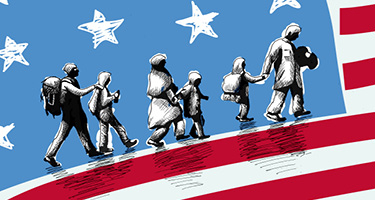For more on employment law, workers' compensation and unionized workforces, check out our digital Employment & Workers' Compensation publication, available here on June 21, 2021.
America’s economy and workforce are at the forefront of the COVID-19 pandemic crisis, which is challenging employers in unprecedented ways. Private employers across every industry are now grappling with not only how to operate and sustain their businesses, but how best to meet the needs of their workforce and clientele given business considerations and federal, state, and local laws or ordinances. For example, the President signed into law the Families First COVID-19 Response Act. Many state and local governments have also responded to the COVID-19 pandemic by enacting worker and community protection laws and/or ordinances. These are all to be applied in combination with other existing federal and state labor and employment laws. Thus, from hospitality to healthcare, retail to manufacturing, employers are adjusting to what seems to be the “new normal” in terms of their rights and responsibilities for the immediate future.
The challenges are confronting employers with unionized and non-unionized workforces alike. At Fisher Phillips, our COVID-19 task force of seasoned traditional labor and employment attorneys has taken the lead on providing guidance to employers that will ensure compliance with employment laws as well as the National Labor Relations Act (NLRA). Here is a sample of some of the labor and employment law questions we have received from our clients as well as a summary of our answers.
What’s the main workplace safety guidance we should follow?
The Occupational Safety and Health Administration (OSHA) recently published Guidance on Preparing Workplaces for COVID-19, outlining steps employers can take to help protect their workforce. OSHA has divided workplaces and work operations into four risk zones, according to the likelihood of employees’ occupational exposure during a pandemic. These risk zones are useful in determining appropriate work practices and precautions.
Can we ask an employee to stay home or leave work if they exhibit symptoms of COVID-19?
Yes, you are permitted to ask them to seek medical attention and get tested for COVID-19. The Centers for Disease Prevention and Control (CDC) states that employees who exhibit symptoms of influenza-like illness at work during a pandemic should leave the workplace. The Equal Employment Opportunity Commission (EEOC) confirmed that advising workers to go home is permissible and not considered disability-related if the symptoms present are akin to those of COVID-19.
Can I take an employee’s temperature at work to determine whether they might be infected?
Yes. The EEOC confirmed that measuring employees’ body temperatures are permissible given the current circumstances. While the Americans with Disabilities Act (ADA) places restrictions on the inquiries that an employer can make into an employee’s medical status, the EEOC considers taking an employee’s temperature to be a “medical examination” under the ADA. The federal agency recognizes the need for this action now because the CDC and state/local health authorities have acknowledged the community spread of coronavirus and have issued attendant precautions. However, as a practical matter, an employee may be infected with COVID-19 without exhibiting recognized symptoms such as a fever, so temperature checks may not be the most effective method for protecting your workforce.
An employee of ours has tested positive for coronavirus. What should we do?
You should send home all employees who worked closely with that employee for a 14-day period of time to ensure the infection does not spread. Before the employee departs, ask them to identify all individuals who worked in close proximity (three to six feet) with them in the previous 14 days to ensure you have a full list of those who should be sent home. When sending the employees home, do not identify by name the infected employee or you could risk a violation of confidentiality laws. If you work in a shared office building or area, you should inform building management so they can take whatever precautions they deem necessary.
One of our employees has been exposed to the virus but only found out after they had interacted with clients and customers. What should we do?
Take the same precautions as noted above with respect to coworkers, treating the situation as if the exposed employee has a confirmed case of COVID-19 and sending home potentially infected employees that he came into contact with. As for third parties, you should communicate with customers and vendors that came into close contact with the employee to let them know about the potential of a suspected case.
Can an employee refuse to come to work for fear of COVID-19 Exposure?
Employees are only entitled to refuse to work if they believe they are in imminent danger. Section 13(a) of the Occupational Safety and Health Act (OSHA) defines “imminent danger” to include “any conditions or practices in any place of employment which are such that a danger exists which can reasonably be expected to cause death or serious physical harm immediately or before the imminence of such danger can be eliminated through the enforcement procedures otherwise provided by this Act.” OSHA discusses imminent danger as where there is “threat of death or serious physical harm,” or “a reasonable expectation that toxic substances or other health hazards are present, and exposure to them will shorten life or cause substantial reduction in physical or mental efficiency.”
Additionally, Section 7 of the NLRA extends broad-based statutory protection to those employees (in union and non-union settings alike) to engage in “protected concerted activity for mutual aid or protection.” Such activity has been defined to include circumstances in which two or more employees act together to improve their employment terms and conditions, although it has been extended to individual action expressly undertaken on behalf of co-workers.
On its own website, the National Labor Relations Board (NLRB) offers a number of examples, including, “talking with one or more employees about working conditions,” “participating in a concerted refusal to work in unsafe conditions,” and “joining with co-workers to talk to the media about problems in your workplace.” Employees are generally protected against discipline or discharge for engaging in such activity.
Our organization recently received a union representation petition, and the NLRB has since scheduled a secret ballot election. Is that election likely to go forward as scheduled?
Not likely, if the election is scheduled prior to April 4, 2020. On March 19, the NLRB announced that all representation elections (including mail ballot elections) scheduled for the following two weeks are suspended until April 4 due to circumstances surrounding the COVID-19 pandemic. Consequently, if you have a union representation election pending, it will not take place until April 4 at the earliest. Further extensions are certainly possible, as the agency is now operating under a mandatory telework order. Therefore, employers are encouraged to closely monitor this situation for further developments.
Does our Collective Bargaining Agreement (CBA) exempt us from complying with new federal emergency FMLA expansion and paid leave requirements or related federal provisions?
Probably not. The Families First Coronavirus Response Act (which applies to employers with less than 500 employees) states that its provisions may not operate to “diminish” benefits in pending CBAs. It does not, however, exempt those CBAs from meeting the new legal requirements. Other statutory frameworks allow for the establishment of the floor so as to not require stacking of the leave (e.g., FMLA and Title VII of the Civil Rights Act).
Generally speaking, a CBA can provide greater protection than that afforded by law, but it cannot provide less protection. Nonetheless, the Families First Coronavirus Response Act does permit employers covered by multiemployer bargaining agreements to make additional contributions to their multiemployer trust or benefit plans in lieu of offering the new paid leave.
We are in negotiations with a union for a new CBA. Are we obligated to continue meeting with the Union at reasonable times and places for bargaining purposes?
Yes, but the question is what does “meet” mean. Absent any emergency guidance by the NLRB, the parties are generally required to continue engaging in good faith negotiations for a new agreement. The good faith requirement, however, does not impose a minimum standard in terms of frequency, duration, or even nature of bargaining sessions, and things such as schedules, safety concerns, and inability to travel may be taken into account if the NLRB is ever called upon to evaluate whether a party engaged in good faith bargaining during the COVID-19 pandemic.
To best protect your interests under these unique circumstances, you are encouraged to regularly communicate with the union regarding your desire to further the bargaining process and explain any operational or business challenges that may pose constraints on the ability to meet and negotiate. As always, if the union suggests a bargaining date that does not work from a logistical or operational standpoint, be sure to articulate (preferably in writing) why, and be prepared to consider alternatives, including telephonic conferences or video-conferencing sessions. The key to meeting your good faith bargaining allegations is to stay engaged and communicate on a proactive basis.
Can my company make changes to unionized employees’ work schedules or duties in response to the coronavirus?
The NLRA imposes on employers the duty to bargain in good faith over mandatory subjects of bargaining such as wages, hours, and terms and conditions of employment. Absent specific language in a collective bargaining agreement permitting such unilateral action; employers who make unilateral changes to terms and conditions of employment risk incurring unfair labor practice charges, even in emergency situations such as this one. Generally, unionized employers should first look to their collective bargaining agreements to determine their rights and obligations with respect to terms and conditions of employment and/or changes thereto.
A labor union representing some of our workers have sent us an information request seeking a number of items, ranging from a copy of our COVID-19 business plan to detailed information about how we intend to manage the crisis. Are we required to respond?
If you maintain unprivileged documents fitting these descriptions, you would likely have to furnish them to the extent they otherwise relate to employment terms and conditions. Therefore, you should consider consulting with legal counsel before embarking upon the development of any strategic plans to address COVID-19 issues. If you have already developed a plan and no privilege applies, it may still raise certain confidentiality concerns, especially within the healthcare industry (where patient privacy laws may also apply).
Would the No-Strike clause in our CBA prohibit our union employees from refusing to work?
Maybe. The answer depends on a host of factors ranging from the articulated rationale for the refusal to work to the specific language of the No-Strike clause itself. There are also special considerations for healthcare institutions to be considered. Most No-Strike provisions, however, preclude the covered union employees from striking or otherwise refusing to perform work. Longstanding labor relations doctrine generally requires bargaining-unit employees to “work now, and grieve later.” Thus, the union employees are generally not at liberty to refuse legitimate work directives or to refuse to work.
However, according to the NLRB’s website, “it should be noted that not all refusals to work are considered strikes and thus violations of no-strike provisions. A walkout because of conditions abnormally dangerous to health, such as a defective ventilation system in a spray-painting shop, has been held not to violate a no-strike provision.” Additionally, a No-Strike clause would not necessarily supersede Section 13(a) of OSHA, entitling all employees to refuse to work if they reasonably believe they are in imminent danger, and compelling employees (particularly in high-risk industries) to report for work under such circumstances may also present adverse public relations implications. Consequently, circumstances like these are best examined on a case-by-case basis under the advice of counsel and, in some circumstances, following dialogue with the authorized bargaining representative.
These are indeed trying times for all employers in the United States. It is critical that trusted legal advisors are prepared and able to respond to the needs of unionized and non-unionized employers applying not only to existing employment laws (such as HIPAA and ADA or their state/local equivalents) but also the newly enacted laws and local ordinances related to COVID-19 as well as the NLRA. At Fisher Phillips, we are well-positioned to meet this need. Our COVID-19 Task Force maintains a comprehensive and updated FAQ for employers on the COVID-19 on a daily basis. The above answers are provided as general guidance and not specific to any particular set of facts. Care should be taken in any given situation to ensure the legal advice fits your unique situation. We are available to provide direct advice, counsel, and support specifically tailored to client needs.
Letitia Silas is a partner at the Bethesda, MD office. Steven M. Bernstein is a managing partner at the firm's Tampa, FL office and co-chair of the firm's Labor Relations practice group. Both are members of the firm's COVID-19 Taskforce, a cross-disciplinary team of attorneys dedicated to advising employers on the many workplace law aspects of the global coronavirus pandemic.

































